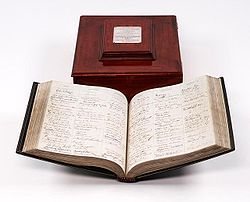Kishinev pogrom
- This article is part of the History of the Jews in Bessarabia.

The Kishinev pogrom was an anti-Jewish riot that took place in Kishinev, then the capital of the Bessarabia province of the Russian Empire (now Chişinău, the capital of Moldova) on April 6-7, 1903.
First pogrom
The riot started after an incident on February 6 when a Christian Russian boy, Michael Rybachenko, was found murdered in the town of Dubossary (now Dubăsari), about 25 miles north of Kishinev. Although it was clear that the boy had been killed by a relative (who was later found), the Russian-language anti-Semitic newspaper Бессарабец (Bessarabetz, meaning "Bessarabian"), published by Pavel Krushevan, insinuated that he was killed by the Jews. Another newspaper, Свет (Svet, "Light"), used the ages-old blood libel against the Jews (alleging that the boy had been killed to use his blood in preparation of matzo).

The Kishinev pogrom spanned three days of rioting against the Jews. Forty-seven (some put the figure as high as 49) Jews were killed, 92 severely wounded, 500 slightly wounded and over 700 houses looted and destroyed. The Times published a forged dispatch by Vyacheslav von Plehve, the Minister of Interior, to the governor of Bessarabia, which supposedly gave orders not to stop the rioters,[1] but, in any case, no attempt was made by the police or military to intervene to stop the riots until the third day. This non-intervention is an argument in support of the opinion that the pogrom was sponsored or, at least, tolerated by the state.
The New York Times described the first Kishinev pogrom:
- The anti-Jewish riots in Kishinev, Bessarabia, are worse than the censor will permit to publish. There was a well laid-out plan for the general massacre of Jews on the day following the Russian Easter. The mob was led by priests, and the general cry, "Kill the Jews," was taken- up all over the city. The Jews were taken wholly unaware and were slaughtered like sheep. The dead number 120 and the injured about 500. The scenes of horror attending this massacre are beyond description. Babes were literally torn to pieces by the frenzied and bloodthirsty mob. The local police made no attempt to check the reign of terror. At sunset the streets were piled with corpses and wounded. Those who could make their escape fled in terror, and the city is now practically deserted of Jews. [2]
Actual casualty figures ended up being approximately 49.
Second pogrom
A second pogrom took place on October 19-20, 1905. This time the riots began as political protests against the Tsar, but turned into an attack on Jews wherever they could be found. By the time the riots were over, 19 Jews were killed and 56 were injured. Jewish self-defense leagues, organized after the first pogrom, stopped some of the violence, but were not wholly successful.
Results of the pogroms

Despite a world outcry, only two men were sentenced to seven and five years and twenty-two were sentenced for one or two years. This pogrom was instrumental in convincing tens of thousands of Russian Jews to leave to the West and eventually to the land of Israel.
As such, it became a rallying point for early Zionists, especially what would become Revisionist Zionism, inspiring early self-defense leagues under leaders like Vladimir Jabotinsky.
A large number of artists and writers addressed the Kishinev pogrom. Russian authors such as Vladimir Korolenko wrote about the pogrom in House 13, while Tolstoy and Gorky wrote condemnations blaming the Russian government — a change from the earlier pogroms of the 1880s, when most members of the Russian intelligentsia were silent. It also had a major impact on Jewish art and literature. Playwright Max Sparber took the Kishinev pogrom as the subject for one of his earliest plays. Poet Chaim Bialik wrote "In the City of Slaughter," about the perceived passivity of the Jews in the face of the mobs:
- ...the heirs
- Of Hasmoneans lay, with trembling knees,
- Concealed and cowering—the sons of the Maccabees!
- The seed of saints, the scions of the lions!
- Who, crammed by scores in all the sanctuaries of their shame,
- So sanctified My name!
- It was the flight of mice they fled,
- The scurrying of roaches was their flight;
- They died like dogs, and they were dead!
Notes
- ^ YIVO Institute for Jewish Research: Pogroms
- ^ "Jewish Massacre Denounced", New York Times, April 28, 1903, p 6.
References
- Kishinev Pogrom unofficial commemorative website
- Rosenthal, Herman and Rosenthal, Max, "Kishinef (Kishinev)", in the Jewish Encyclopedia (1901-1906)
- Resources about Kishinev pogrom
